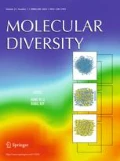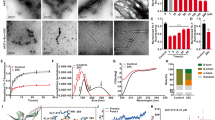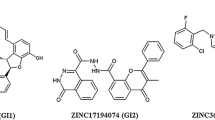Abstract
Inhibition of Sirtuin2 (SIRT2) protein rescues the α-synuclein toxicity in vitro and in vivo models of Parkinson’s disease (PD). Thioacetyl group can structurally mimic the acetyl group and restrain the deacetylating p53 reaction by SIRT2. This work evaluated the biological activity of designed pentapeptides inhibitor containing N-thioacetyl-lysine against SIRT2. Pentapeptide by introducing thioacetyl-lysine as an inhibitor of SIRT2 was screened by molecular docking and synthesized by solid phase method. The inhibition of pure recombinant SIRT2 as well as SIRT2 in serum of PD patients by peptide was done by fluorescent activity assay. The inhibition of SIRT2 was assessed in PC12 cell line by measuring acetylated α-tubulin level. The peptide YKK(ε-thioAc)AM and HRK(ε-thioAc)AM were found to be SIRT2 inhibitors by molecular docking. However, YKK(ε-thioAc)AM was more specific towards SIRT2 than SIRT1 (Sirtuin1). It inhibited recombinant SIRT2 by IC50 value of 0.15 µM and KD values 9.92 × 10−8/M. It also inhibited serum SIRT2 of PD. It increased the acetylation of α-tubulin in PC12 neuroblastoma cells which is essential for maintaining the microtubular cell functions of brain. It can be concluded that novel peptide YKK(ε-thioAc)AM may be a platform for therapeutic agent for Parkinson’s disease targeting SIRT2.
Graphic abstract




Similar content being viewed by others
Data availability
The data that support the findings of this study are openly available in manuscript, figures and tables.
References
Greenamyre JT, Hastings TG (2004) Biomedicine: Parkinson’s—divergent causes, convergent mechanisms. Science 304:1120–1122. https://doi.org/10.1126/science.1098966
Grabowska W, Sikora E, Bielak-Zmijewska A (2017) Sirtuins, a promising target in slowing down the ageing process. Biogerontology 18:447–476. https://doi.org/10.1007/s10522-017-9685-9
Guarente L (2007) Sirtuins in aging and disease. Cold Spring Harb Symp Quant Biol 72:483–488. https://doi.org/10.1007/978-1-62703-637-5_1
Singh P, Hanson PS, Morris CM (2017) SIRT1 ameliorates oxidative stress induced neural cell death and is down-regulated in Parkinson’s disease. BMC Neurosci 18:46–58. https://doi.org/10.1186/s12868-017-0364-1
Kazantsev AG, Kolchinsky AM (2008) Central role of alpha-synuclein oligomers in neurodegeneration in Parkinson’s disease. Arch Neurol 65:1577–1581. https://doi.org/10.1001/archneur.65.12.1577
Portran D, Schaedel L, Xu Z, Manuel T, Maxence VN (2017) Tubulin acetylation protects long-lived microtubules against mechanical ageing. Nat Cell Biol 19:391–398. https://doi.org/10.1038/ncb3481
Singh AP, Ramana G, Bajaj T, Singh V, Dwivedi SN, Behari M, Dey AB, Dey S (2019) Elevated serum SIRT2 may differentiate Parkinson’s disease from atypical Parkinsonian syndromes. Front Mol Neurosci 12:129. https://doi.org/10.3389/fnmol.2019.00129
Garske AL, Smith BC, Denu JM (2007) Linking SIRT2 to Parkinson’s disease. ACS Chem Biol 2:529–532. https://doi.org/10.1021/cb700160d
Liu L, Arun A, Ellis L, Peritore C, Donmez G (2014) SIRT2 enhances 1-methyl-4-phenyl-1,2,3,6-tetrahydropyridine (MPTP)-induced nigrostriatal damage via apoptotic pathway. Front Aging Neurosci 6:184–189. https://doi.org/10.3389/fnagi.2014.00184
Outeiro TF, Kontopoulos E, Altmann SM, Kufareva I, Strathearn KE, Allison M (2007) Sirtuin 2 inhibitors rescue α-synuclein-mediated toxicity in models of Parkinson disease. Science 317:516–519. https://doi.org/10.1126/science.1143780
D’Hondt M, Bracke N, Taevernier L, Gevaert B, Verbeke F, Wynendaele E, Spiegeleer DB (2014) Related impurities in peptide medicines. J Pharm Biomed Anal 101:2–30. https://doi.org/10.1016/j.jpba.2014.06.012
Smith BC, Denu JM (2007) Sir2 deacetylases exhibit nucleophilic participation of acetyl-lysine in NAD + cleavage. J Am Chem Soc 129:5802–5803. https://doi.org/10.1021/ja070162w
Fatkins DG, Monnot AD, Zheng W (2006) A multi-facet functional probe for enzymatic protein lysine Nε-deacetylation. Bioorg Med Chem Lett 16:3651–3656. https://doi.org/10.1016/j.bmcl.2006.04.075
Schrödinger Release 2020-2 (2020) LigPrep. Schrödinger, LLC, New York, NY
Cao D, Wang M, Qiu X, Liu D, Jiang H, Yang N, Xu RM (2015) Structural basis for allosteric, substrate-dependent stimulation of SIRT1 activity by resveratrol. Genes Dev 29(12):1316–1325. https://doi.org/10.1101/gad.265462.115
Wang Y, Zhang WZ, Hao Q (2016) Sirt2 in complex with a myristoyl peptide. https://doi.org/10.2210/pdb4x3o/pdb (under publication)
Cui H, Kamal Z, Ai T, Xu Y, More S, Wilson D D, Chen L (2014) Discovery of potent and selective sirtuin2 (SIRT2) inhibitors using a fragment-based approach. J Med Chem 57:8340–8357. https://doi.org/10.1021/jm500777s
Heinke R, Carlino L, Kannan S, Jung M, Sippl W (2011) Computer- and structure-based lead design for epigenetic targets. Bioorg Med Chem 19:3605–3615. https://doi.org/10.1016/j.bmc.2011.01.029
Neugebauer RC, Uchiechowska U, Meier R, Hruby H, Valkov V, Verdin E, Sippl W, Jung M (2008) Structure–activity studies on splitomicin derivatives as sirtuin inhibitors and computational prediction of binding mode. J Med Chem 51:1203–1213. https://doi.org/10.1021/jm700972e
Somvanshi RK, Kumar A, Kant S, Gupta D, Singh Bhaskar S, Das U, Srinivasan A, Singh TP, Dey S (2007) Surface plasmon resonance studies and biochemical evaluation of a potent peptide inhibitor against cyclooxygenase-2 4 as an anti-inflammatory agent. Biochem Biophys Res Commun 361:37–42. https://doi.org/10.1016/j.bbrc.2007.06.122
Shekhar S, Yadav SK, Rai N, Kumar R, Yadav Y, Tripathi M, Dey AB, Dey S (2017) Affiliations expand. 5-LOX in Alzheimer’s disease: potential serum marker and in vitro evidences for rescue of neurotoxicity by its inhibitor YWCS. Mol Neurobiol 55:2754–2762. https://doi.org/10.1007/s12035-017-0527-1
Moniot S, Schutkowski M, Steegborn C (2013) Crystal structure analysis of human Sirt2 and its ADP-ribose complex. J Struct Biol 182:136–143. https://doi.org/10.1016/j.jsb.2013.02.012
Yamagata K, Goto Y, Nishimasu H, Morimoto J, Ishitani R, Dohmae N, Takeda N, Nagai R, Komuro I, Suga H, Nureki O (2014) Structural basis for potent inhibition of SIRT2 deacetylase by a macrocyclic peptide inducing dynamic structural change. Structure 22:345–352. https://doi.org/10.1016/j.str.2013.12.001
Friesner RA, Murphy RB, Repasky MP, Frye LL, Greenwood JR, Halgren TA, Paul CS, Mainz DT (2006) Extra precision glide: docking and scoring incorporating a model of hydrophobic enclosure for protein–ligand complexes. J Med Chem 49:6177–6196. https://doi.org/10.1021/jm051256o
Schutkowski M, Fischer F, Roessler C, Steegborn C (2014) New assays and approaches for discovery and design of Sirtuin modulators. Expert Opin Drug Discov 9:183–199. https://doi.org/10.1517/17460441.2014.875526
Nogales E (2000) Structural insights into microtubule function. Annu Rev Biochem 69:277–302. https://doi.org/10.1146/annurev.biochem.69.1.277
Acknowledgements
Authors acknowledge Council of Scientific and Industrial Research (CSIR) for providing funds for the consumable items.
Funding
Council of Scientific and Industrial Research (CSIR) (Grant No. 27(0335)/18/EMR-II) provided fund for the consumable items.
Author information
Authors and Affiliations
Corresponding author
Ethics declarations
Conflict of interest
The authors declare that they have no conflict of interest.
Ethical approval
Ethical approval was obtained from the All India Institute of Medical Sciences ethics committee (IEC-566/03 0.11.2017, RP-02/2017), New Delhi, India and written informed consent was recorded from the participants.
Additional information
Publisher's Note
Springer Nature remains neutral with regard to jurisdictional claims in published maps and institutional affiliations.
Electronic supplementary material
Below is the link to the electronic supplementary material.
Rights and permissions
About this article
Cite this article
Singh, A.P., Nigam, L., Yadav, Y. et al. Design and in vitro analysis of SIRT2 inhibitor targeting Parkinson’s disease. Mol Divers 25, 2261–2270 (2021). https://doi.org/10.1007/s11030-020-10116-z
Received:
Accepted:
Published:
Issue Date:
DOI: https://doi.org/10.1007/s11030-020-10116-z




